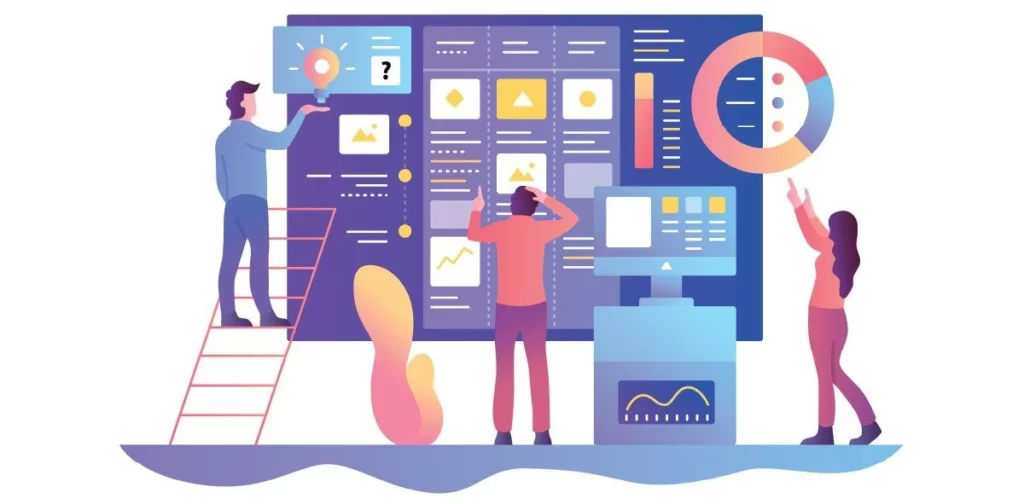In the ever-evolving landscape of agile project management, the Agile methodology has emerged as a transformative force, providing a dynamic and responsive framework for delivering projects in a rapidly changing environment. As we step into 2024, the principles of Agile project management continue to gain prominence, offering organisations the flexibility and adaptability needed to navigate the complexities of today’s business landscape. This comprehensive guide explores the key strategies and principles for mastering Agile project management in 2024, encompassing methodologies, tools, team dynamics, and continuous improvement.
Understanding the Foundations of Agile Project Management
Agile Methodologies Overview
Agile is not a one-size-fits-all methodology; rather, it represents a set of principles and practices designed to prioritise flexibility, collaboration, and customer satisfaction. Explore various Agile methodologies, including Scrum, Kanban, and Extreme Programming (XP), to understand their unique approaches and applications. Tailor your Agile implementation to align with the specific needs and dynamics of your projects.
Agile Manifesto and Principles
Delve into the Agile Manifesto and its underlying principles. Embrace the core values of individuals and interactions, working solutions, customer collaboration, and responding to change. Understanding the principles that underpin Agile methodologies provides a solid foundation for effective agile project management and delivery.
Implementing Agile Methodologies

Scrum: Framework for Iterative Development
Explore Scrum as a widely adopted Agile framework. Understand the roles of Product Owner, Scrum Master, and Development Team, and the ceremonies of Sprint Planning, Daily Stand-ups, Sprint Review, and Sprint Retrospective. Implementing Scrum involves breaking down complex projects into manageable increments, fostering transparency, and enabling continuous improvement.
Kanban: Visualising Workflows
Embrace Kanban as a visual agile project management tool that provides transparency into work processes. Utilise Kanban boards to visualise workflow stages, limit work in progress, and optimise the flow of tasks. Kanban’s emphasis on continuous delivery and incremental improvements aligns with the Agile philosophy.
Extreme Programming (XP): Embracing Agility in Coding
Explore Extreme Programming (XP) as an Agile methodology that places a strong emphasis on coding excellence. Incorporate practices such as pair programming, test-driven development, and continuous integration to enhance code quality, reduce defects, and promote collaboration among team members.
Building Agile Teams and Culture
Cross-Functional Teams
Form cross-functional teams that bring together individuals with diverse skills necessary for end-to-end project delivery. Cross-functional teams promote collaboration, reduce dependencies, and enhance the team’s ability to adapt to changing requirements. Foster a culture of shared responsibility and mutual accountability within the team.
Empowering Self-Organizing Teams
Empower teams to be self-organising and self-managing. Provide autonomy for decision-making, encourage open communication, and create an environment that allows teams to take ownership of their work. Self-organising teams are better equipped to respond to challenges and deliver value iteratively.
Cultivating Agile Leadership
Develop Agile leadership that supports and nurtures the Agile mindset within the organisation. Agile leaders foster a culture of continuous improvement, embrace change, and champion collaboration. Leadership that understands and embodies Agile principles is instrumental in creating an environment conducive to successful Agile project management.
Effective Agile Communication

Daily Stand-ups: Enhancing Communication
Implement daily stand-up meetings as a cornerstone of effective Agile communication. These short, focused meetings allow team members to share progress, discuss challenges, and synchronise efforts. Daily stand-ups promote transparency, identify impediments, and ensure that everyone is aligned towards the project goals.
Sprint Reviews: Collaboration and Feedback
Conduct Sprint Reviews to showcase the completed work to stakeholders. This collaborative session provides an opportunity for feedback, aligns expectations, and allows for adjustments based on stakeholder input. Effective communication during Sprint Reviews ensures that the delivered product meets customer expectations.
Sprint Retrospectives: Continuous Improvement
Facilitate Sprint Retrospectives to reflect on the team’s performance and identify areas for improvement. This regular feedback loop allows the team to celebrate successes, address challenges, and implement changes to enhance future sprints. Sprint Retrospectives contribute to a culture of continuous improvement within the Agile framework.
Agile Metrics and Monitoring
Velocity: Measuring Team Progress
Use velocity as a key metric to measure a team’s progress in completing work during a sprint. Velocity is calculated by summing up the story points or tasks completed in each sprint. Monitoring velocity over time helps teams estimate future work, identify bottlenecks, and optimise their capacity planning.
Lead Time and Cycle Time: Analysing Workflow Efficiency
Analyse lead time and cycle time to assess the efficiency of your workflow. Lead time measures the time from the initiation of work to its completion, while cycle time measures the time taken to complete a specific task. Understanding these metrics helps teams identify areas for improvement and streamline their processes.
Burndown Charts: Visualising Progress
Utilise burndown charts to visualise the progress of the team’s work throughout a sprint. These charts track the remaining work against time, providing a clear picture of whether the team is on track to complete the planned work by the end of the sprint. Burndown charts enhance transparency and aid in decision-making.
Scaling Agile for Larger Projects
Scrum of Scrums: Coordinating Multiple Teams
Implement the Scrum of Scrums approach when scaling Agile for larger projects. This involves representatives from individual Scrum teams participating in a higher-level Scrum meeting to coordinate efforts, share information, and address inter-team dependencies. Scrum of Scrums facilitates collaboration in larger project environments.
SAFe Framework: Scaled Agile for Enterprises
Explore the Scaled Agile Framework (SAFe) as a comprehensive framework for scaling Agile principles to the enterprise level. SAFe provides a structured approach to large-scale Agile transformation, incorporating principles from Lean and systems thinking. Implementing SAFe involves organising teams into Agile Release Trains (ARTs) to facilitate alignment and coordination.
Handling Change and Uncertainty

Adapting to Changing Requirements
Agile embraces change and uncertainty as inherent parts of the agile project management process. Adopt a mindset that welcomes changes to requirements, priorities, and scope. Establish mechanisms, such as backlog refinement sessions and dynamic sprint planning, to effectively accommodate changes and ensure that the project remains aligned with evolving priorities.
Risk Management in Agile
Integrate risk management into the Agile project management process. Identify potential risks early in the project, prioritise them based on impact and likelihood, and develop strategies for mitigation. Regularly revisit and reassess risks throughout the project’s lifecycle, adjusting strategies as needed to address emerging challenges.
Continuous Learning and Improvement
Kaizen Philosophy: Embracing Continuous Improvement
Embrace the Kaizen philosophy of continuous improvement within the Agile framework. Create a culture where teams regularly reflect on their processes, collaborate to identify areas for improvement, and implement changes incrementally. Kaizen fosters a mindset of continuous learning and adaptation.
Retrospectives for Team Reflection
Conduct regular retrospectives at the end of each sprint to facilitate team reflection. Encourage open and honest discussions about what worked well, what could be improved, and how the team can enhance its performance. Retrospectives contribute to a culture of shared learning and continuous improvement.
Leveraging Agile Project Management Tools

Jira, Trello, and Asana: Streamlining Workflows
Explore agile project management tools such as Jira, Trello, and Asana to streamline Agile workflows. These tools offer features like backlog management, sprint planning, and visual boards that enhance collaboration and transparency. Choose a tool that aligns with your team’s preferences and project requirements.
VersionOne and Rally: Enterprise Agile Platforms
Consider enterprise Agile platforms like VersionOne and Rally for managing large-scale Agile projects. These platforms provide comprehensive features for portfolio agile project management, program coordination, and reporting. Enterprise Agile platforms are designed to scale Agile practices effectively across complex organisational structures.
Conclusion:
As we navigate the challenges and opportunities of 2024, mastering Agile project management remains a strategic imperative for organisations aiming for flexibility, responsiveness, and customer satisfaction. By understanding the diverse methodologies, building empowered and cross-functional teams, embracing effective communication, leveraging metrics for insights, scaling Agile for larger projects, handling change and uncertainty, and fostering a culture of continuous learning, organisations can excel in Agile project management.
The Agile journey is not a destination but a continuous evolution. With each sprint, each retrospective, and each adaptation, teams and organisations refine their processes and enhance their ability to deliver value in a rapidly changing world. As you embark on your Agile project management journey in 2024, let these principles and strategies be your guide to unlocking the full potential of Agile methodologies and fostering a culture of excellence within your teams.

Insightful Blogger Navigating News, Business, Tech, and More on its newsy: Meet Herman Danner, a seasoned blogger on its newsy, with a keen eye for dissecting the latest in news, unraveling business dynamics, and exploring the ever-evolving landscape of technology. Herman’s blogs offer a multifaceted perspective on various niches, providing readers with insightful analyses and a comprehensive view of the fast-paced world we live in. Join Herman on its newsy for a thought-provoking journey through news, business, tech, and beyond. Contact: [email protected]